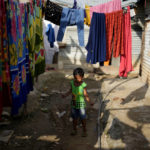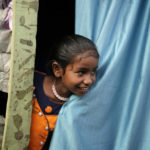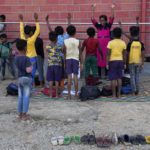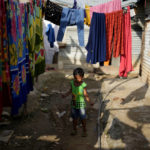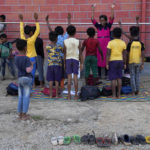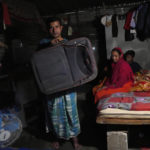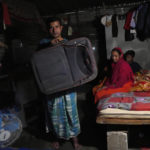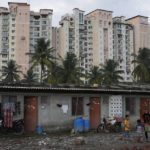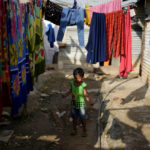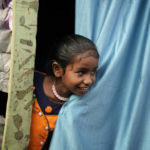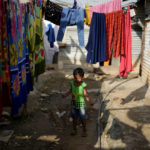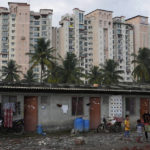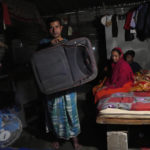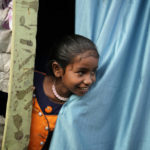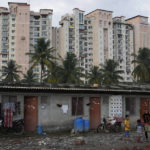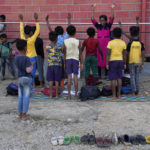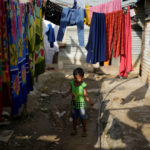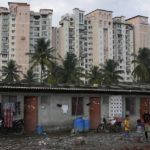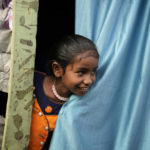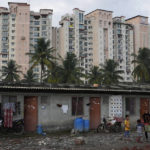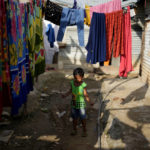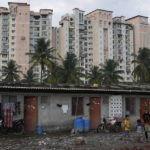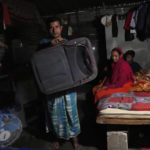Climate Migration: Indian kids find hope in a new language
Sep 21, 2022, 8:01 AM | Updated: Sep 27, 2022, 1:43 pm
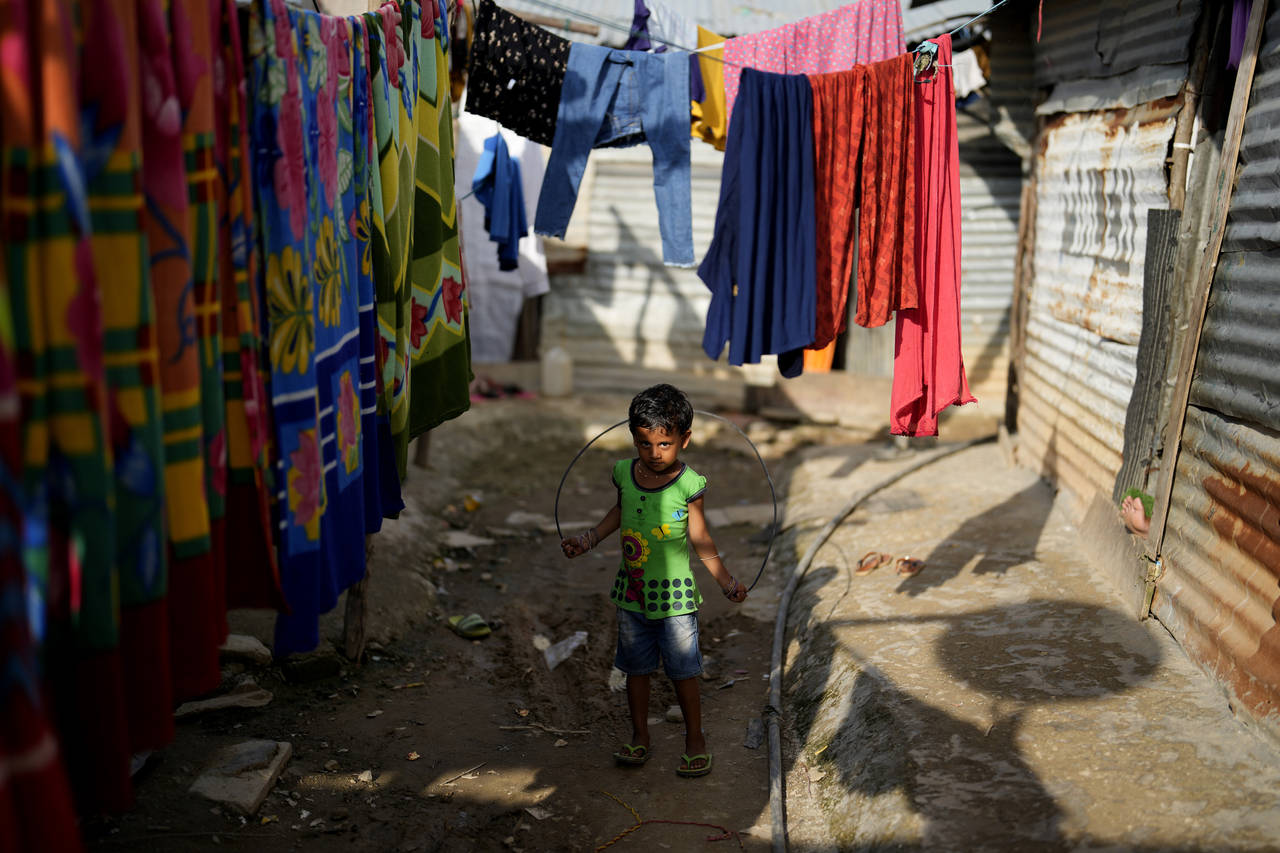
A child plays with a jump rope in a narrow lane of a poor neighborhood in Bengaluru, India, Tuesday, July 19, 2022. In this community, most people are from Assam state, many forced to migrate because of climate change and dreaming of a better future. (AP Photo/Aijaz Rahi)
(AP Photo/Aijaz Rahi)
BENGALURU, India (AP) — Eight-year-old Jerifa Islam only remembers the river being angry, its waters gnawing away her family’s farmland and waves lashing their home during rainy season flooding. Then one day in July of 2019, the mighty Brahmaputra River swallowed everything.
Her home in the Darrang district of India’s Assam state was washed away. But the calamity started Jerifa and her brother, Raju 12, on a path that eventually led them to schools nearly 2,000 miles (3,218 kilometers) away in Bengaluru, where people speak the Kannada language that is so different from the children’s native Bangla.
Those early days were difficult. Classes at the free state-run schools were taught in Kannada, and Raju couldn’t understand a word of the instruction.
But he persisted, reasoning that just being in class was better than the months in Assam when submerged roads kept him away from school for months. “Initially I didn’t understand what was happening, then with the teacher explaining things to me slowly, I started learning,” he said.
___
EDITOR’S NOTE: This story is part of an ongoing series exploring the lives of people around the world who have been forced to move because of rising seas, drought, searing temperatures and other things caused or exacerbated by climate change.
___
The children were born in a low-lying village, flanked by the Himalayas and the river. Like many parts of northeastern India, it was no stranger to heavy rains and naturally occurring floods.
But their father, Jaidul Islam, 32, and mother Pinjira Khatun, 28, knew something had changed. The rains had become more erratic, flash floods more frequent and unpredictable. They were among the estimated 2.6 million people in the Assam state affected by floods the year they decided to move to Bengaluru, a city of over 8 million known as India’s Silicon Valley.
No one in their family had ever moved so far from home, but any lingering doubts were outweighed by dreams of a better life and a good education for their children. The couple spoke a little Hindi — India’s most widely used language — and hoped that would be enough to get by in the city, where they knew nearby villagers had found work.
The two packed what little they could salvage into a large suitcase they hoped to someday fill with new belongings. “We left home with nothing. Some clothes for the kids, a mosquito net, and two towels. That was it,” said Islam.
The suitcase is now filling up with school exercise books — and the parents, neither with any formal education, said their lives center on ensuring their kids have more opportunities. “My children will not face the same problems that I did,” the father said.
___
The family fled the low-lying Darrang district, which receives heavy rainfall and natural flooding. But rising temperatures with climate change have made monsoons erratic, with the bulk of the season’s rainfall falling in days, followed by dry spells. The district is among the most vulnerable to climate change in India, according to a New-Delhi based thinktank.
Floods and droughts often occur simultaneously, said Anjal Prakash, a research director at India’s Bharti Institute of Public Policy. The natural water systems in the Himalayan region that people had relied on for millennia are now “broken,” he said.
In the past decade, Prakash said, the number of climate migrants in India has been growing. And over the next 30 years, 143 million people worldwide will likely be uprooted by rising seas, drought and unbearable heat, the Intergovernmental Panel on Climate Change reported this year.
India estimates it has around 139 million migrants, but unclear is how many had to move because of climate change. By 2050, cities like Bengaluru are predicted to become the preferred destination for the nearly 40 million people in South Asia forced by climate change to leave their homes, according to a 2021 World Bank report.
“Especially if you’ve aspirations for your second generation, you have to move,” said Prakash.
In the suburban area where Jerifa and her family now live, most people are from Assam state, many forced to migrate because of climate change and dreaming of a better future: There is Shah Jahan, 19, a security guard who wants to be a YouTube influencer. There is Rasana Begum, a 47-year-old cleaner who hopes her two daughters will become nurses. Their homes, too, were washed away in floods.
Pinjira and Jaidul have both found work with a contractor who provides housekeeping staff to the offices of U.S. and Indian tech companies. Jaidul earns $240 a month, and his wife about $200 — compared to the $60 he’d made from agriculture. Raju’s new private school fees cost a third of their income, and the family saves nothing. But, for the first time in years, in their new home — a 10 feet by 12 feet (3 meters by 3.6 meters) room with a tin roof and sporadic electricity — they feel optimistic about the future.
“I like that I can work here. Back home, there was no work for women. … I am happy,” said Pinjira.
For now, Raju dreams of doing well at his new school. He has benefitted from a year-long program run by Samridhi Trust, a non-profit that helps migrant children get back to the education system by teaching them basic Kannada, English, Hindi and math. Teachers test students every two months to help them transition into state-run free schools that instruct in Kannada — or in some cases, like Raju’s, English.
“My favorite subject is math,” said the 12-year-old, adding that his favorite time of day was the bus ride to school. “I love looking out of the window and seeing the city and all the big buildings.”
His sister, who wants to be a lawyer someday, has picked up Kannada faster than he has and chats happily with new classmates at her nearby government school, switching easily between her native and adopted tongues.
Their parents work alternate shifts to ensure somebody is home in case of emergencies. “They are young and can get into trouble, or get hurt,” said Khatun. “And we don’t know anybody here.”
Their anxiety isn’t unique. Many parents worry about safety when they send their children to schools in unfamiliar neighborhoods, said Puja, who uses only one name and coordinates Samridhi Trust’s after-school program.
Children of migrants often tend to drop out, finding classes too hard. But Raju considers his school’s “discipline” refreshing after chaotic life in a poor neighborhood.
His mother misses her family and speaks with them over the phone. “Maybe I’ll go back during their holidays,” she said.
Her husband does not want to return to Assam — where floods killed nine people in their district this year — until the children are in a higher grade. “Maybe in 2024 or 2025,” he said.
Every afternoon, the father waits patiently, scanning the street for Raju’s yellow bus. When home, the boy regales him with stories about his new school. He says he now knows how to say “water” in Kannada, but that none of his new classmates know what a “real flood” looks like.
—-
Follow Aniruddha Ghosal in Twitter: @aniruddhg1
___
Associated Press climate and environmental coverage receives support from several private foundations. See more about AP’s climate initiative here. The AP is solely responsible for all content.
Copyright © The Associated Press. All rights reserved. This material may not be published, broadcast, rewritten or redistributed.

